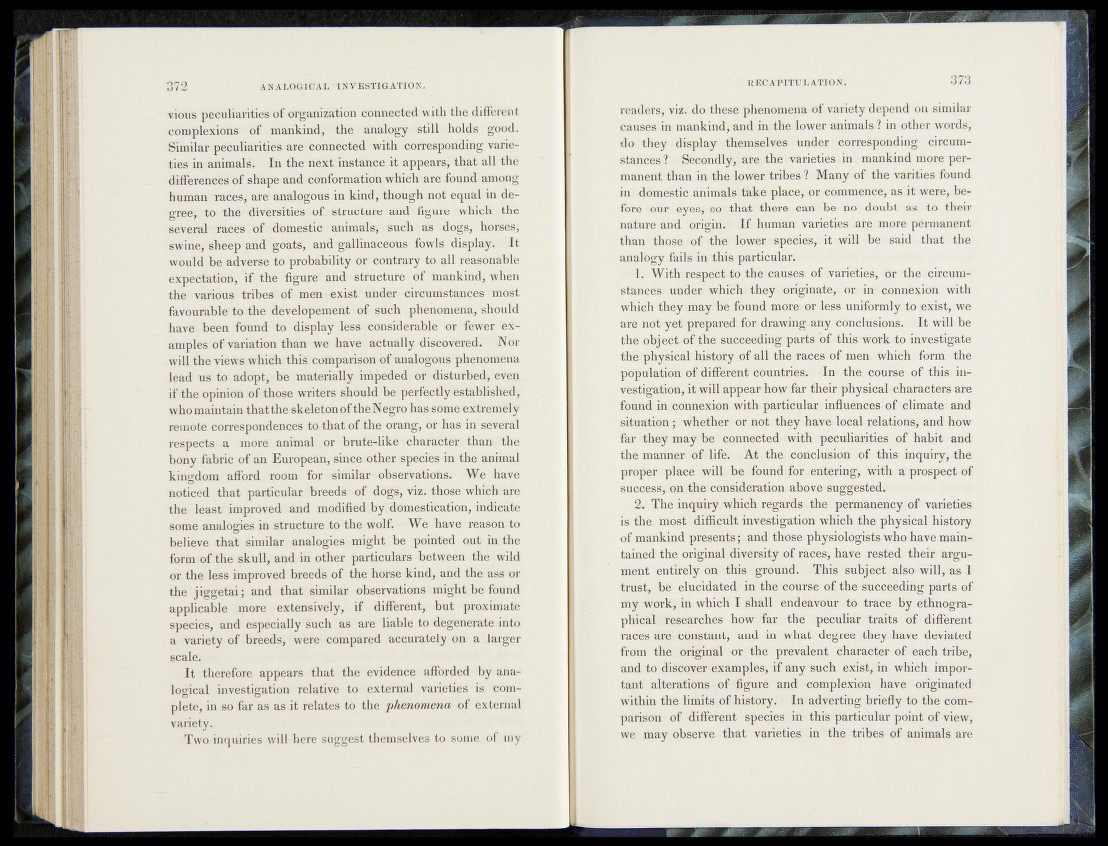
vious peculiarities of organization connected with the different
complexions of mankind, the analogy still holds-good.
Similar peculiarities are connected with ’corresponding varieties
in animals. In the next instance it appears, that all the
differences of shape and conformation which are found! among
human races, are analogous in kind, though not equal in de^
grete, to the diversities o f structure and figure which the
ieveral races of domestic animals, such as “dogs, horses,
swine, sheep and goats, and gallinaceous fowls display. It
would be adverse to probability or contrary to all reasonable
expectation, if the figuye and structure of mankind, when
the various tribes of men exist under circumstances most
favourable to the developement of such phenomena, should
have been found to display less considerable or fewer 'examples
of variation than we have actually discovered. " Nor
will the views which this comparison of analogous( phenomena
lead us to adopt, be materially impeded or disturbed, even
if the opinion of those writers should be perfectly-established,
who maintain thatthe skeleton of the Negro has sonfeSCsêremely
remote correspondences to that of the orang, or has imsevéraff
respeets a more animal or brute-like character than the
bony fabric of an European, since other species in the animal
kingdom afford room for similar - observations. We have
noticed th a t particular breeds of dogs, viz; thoée which are
the least improved and modified by domestication, indicàté
some analogies in structure to the wolf. - We have 'reason to
believe that similar analogies might he pointed out .in the
form of the skull, and in other particulars between the wild
or the less improved breeds of the horse kind, and the ass or
the jiggetai; and that similar observations might be found
applicable more extensively, if diffèrent, but proximate
species, and especially such as are liable to degenerate into
a variety of breeds, were compared accurately on a larger
scale. ,
I t therefore appears th a t the evidence afforded by analogical
investigatioirTelative to external varieties is complete,
in so far as as it relates to the phenomena of external
variety.
Two inquiries wilKhere suggest themselves to some of my
readers, viz. do these phenomena of variety depend on similar
causes in mankind, and in the lower animals '? in other, words,
do theyidisplay themselves^ under corresponding circum-
StaneeS|^.!%e'®ndly4 .are ^he ^Varieties * in mankind more permanent
than in thedower. tribes.? Many of the varities found
in domestic animals take-place, or commence; as it were, before
^out eyfes, so • that thereii can - he no-doubt as to their
nature and 'origin.* I f human varieties are more permanent
than those - . species, it will be said that the
anklbflft fails in this particular.
1. With) respeCtlto thefedus^ of-^varieties, or the circumstances
* under w-hich-they originate,*, or in connexion with
which they-may, be found more# ©ivies® uniformlyito exist, we
are not*yet prepared for drawinguanyssCOnelusions. It will be
the objects of the)«UCeieedirig parts of thisoworkrto. investigate
the physical"history of all the races^df men», which1 form the
population of different countries. In th e1 course of this investigation,
it will appear how far their physical'characters are
found in connexion with particular influences of climate and
situation; whether or not they-have'local relations, and how
far they may be connected with, peculiarities of habit and
the manner of 'life; At the. conclusion of this, inquiry, the
proper place will be found for entering, with a prospect of
success, on the consideration abovp Suggested.
2.. The inquiry which regards the permanency of varieties
is the most difficult investigation which the physical history
of mankind presents; and those physiologists who have maintained
the original diversity of races, have rested their argument
entirely on this ground. This subject - also will, as 1
trust, be elucidated in the course pf the succeeding parts of
my work, in which I shall endeavour to trace by ethnographical
researches how far the peculiar traits of different
races are constant, and in what degree they have deviated
from the original or the prevalent character of each tribe,
and to discover examples/ if any such exist, in which important
alterations of figure and complexion have originated
within the limits of history. In adverting briefly to the comparison
of different species in lliis particular point of view,
we may observe that varieties in the tribes of animals are